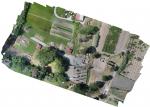Summary (English)
In 2001, the Centre Jean Bérard began a research programme to investigate the Roman necropolis at Cumae, which extended from the northern fortifications, close to the middle gate.
In recent campaigns, the excavations have concentrated on the area immediately in front of the middle gate, where between the late Republican and Flavian periods numerous transformations took place that were related to the modifications undertaken on the walls and the gate.
The filling of the ditch and creation of a new road leading eastwards from the gate in the direction of Monte Grillo can be dated to the late Republican period. Several hypogean or semi-hypogean funerary monuments were built along this road, in which members of the town’s elite were buried.The area in front of the middle gate underwent a second significant intervention during the reign of Domitian involving the obliteration of the secondary road leading east, the destruction of several funerary monuments and the creation of a large basalt-paved square. During this intervention, new imposing structures were built along the edge of the basalt-paved area, and the ground surfaces were raised by the construction of a large terrace immediately to its east, between the walls and the 19th century masseria of Matteo il Procidiano.
These interventions were carried out in order to level a large part of the terrain that was to be used for the construction of a monument with a considerable external space such as a training field destined for the youth of the town’s elite. Today, the entire area, seems to have covered at least 2500 m2 and still preserves the perimeter walls at foundation level, in addition to part of a portico and a series of rooms facing west onto the square. Structures such as this were not unusual in the Roman world, in particular during the Republican period. Vitruvius himself, for example, recalls in De Architectura that sacred buildings, in particular those dedicated to Mars, had to be positioned extra urbem sed ad campum. This evidence, and that from other Roman towns, for example Alba Fucens, whose fields are known, seem to support this first interpretation. Furthermore, the excavations also uncovered several rooms at the western edge of the field, including a caupona.
Test trenches dug in the same sector made it possible to investigate two of the funerary monuments with underground chambers that were obliterated or damaged by the Domitianic restructuring. Both tombs, in which the dead were placed on funerary beds, provided information that dated their construction and final phases of use.
Further excavation between the north wall of the Flavian terrace and the front of the town walls intercepted the levels of the mid -2nd/early 1st century B.C. necropolis below the layers of dumped material used to build the terrace. Two hypogean tombs with barrel vaults were uncovered, both disturbed, and a series of cremation burials in pits with cippus referring to Oscan individuals were identified. One of the chamber tombs (E73) preserved painted figures of great interest.
- Priscilla Munzi- Centre Jean Bérard (USR 3133 CNRS –EFR)
Director
- Jean-Pierre Brun- Collège de France (Paris)
- Priscilla Munzi- Centre Jean Bérard (USR 3133 CNRS –EFR)
Team
- Géraldine Sachau-Carcel - UMR5140 ASM, Archéologie des sociétés méditerranéennes, étude anthropologique
- Henri Duday - CNRS UMR 5199 PACEA, Laboratoire d'Anthropologie des Populations du Passé, Université Bordeaux 1
- Bastien Lemaire - Université Paul Valéry III, Montpellier
- Dorothée Neyme – Centre Jean Bérard, USR3133 CNRS-EFR
- Elisa Conca
- Marina Covolan – Università degli studi di Salerno
- Ophélie Vauxion– Centre Jean Bérard, USR3133 CNRS-EFR
- Guilhem Chapelin- Centre Jean Bérard, USR3133 CNRS-EFR
- Giuseppina Stelo, Centre Jean Bérard, USR 3133 CNRS-EFR
- Jean-Pierre Brun - Collège de France / Centre Jean Bérard, CNRS-EFR
- Priscilla Munzi - Centre Jean Bérard, USR3133 CNRS-EFR
- Marcella Leone - Centre Jean Bérard, USR3133 CNRS - Ecole Française de Rome
Research Body
- Centre Jean Bérard (USR 3133 CNRS – EFR)
Funding Body
- CNRS
- Ministère de l'Europe et des Affaires étrangères (Paris)
- École francaise de Fondation du Collège de France
- École francaise de Rome






![Download [PDF]](/excavation/skins/fasti/images/results/download_sml.png)